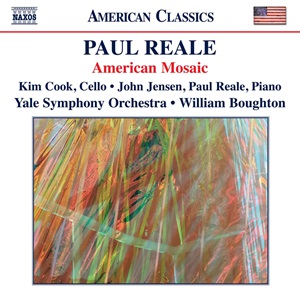
Paul Reale (1943 – 2020)
American Mosaic
Cello Concerto ‘Live Free or Die’ (2018)
Piano Concerto No 1 (1986 rev. 2016/2020)
Piano Sonata No 6 ‘The Waste Land’ (1992)
Kim Cook (cello)
John Jensen (piano)
Paul Reale (piano)
Yale Symphony Orchestra/William Boughton
rec. 2007/22, UCLA, Yale University
First recording: concertos
Naxos 8.559898 [70]
Paul Reale originally studied English and Chemistry at Columbia University, while studying music privately with Chou Wen-Chung and Otto Luening. Post-graduate work was with George Rochberg and George Crumb at the University of Pennsylvania. From 1969-2004, he taught at UCLA. Although a prolific composer, his music was largely ignored in the Los Angeles area. If his works are all as melodious as those on the disc, it is easy to see why, as they are at odds with the dead-end modernism prevalent in American academia until recently.
New Hampshire’s state motto ‘Live free or die’ provided the impetus, and subtitle, for the Cello Concerto, which was written in 2018 in a mere seventeen days following the composer’s terminal cancer diagnosis. It is a wide-ranging work in terms of its musical material. There are crunching dissonances melting into beautiful, long-spun melodies, and thick contrapuntal passages spinning out into ethereal solo lines. The music, with its freewheeling independence of mind, reminded me of the great West Coast innovator Lou Harrison. Like Harrison, Reale makes extensive use of tuned percussion, creating a gamelan-like ensemble that contrasts with the rest of the ensemble. He has very carefully balanced the solo cello line with the orchestra so that the instrument is never dominated by the group. The first two movements, ‘interregnum’ and ‘angels’, are by turns dramatic and surprising. The material sounds as though it will do one thing – maybe a Baroque concerto – but then goes into a totally different direction. In the composer’s poignant programme notes, he observes that he follows a cinematic approach to material. In a film, the same material perhaps observed from different angles or perspectives; so too, here, the musical material is not so much developed in the classical sense as observed from different positions. The finale, ‘funk’, is an orchestral take on big band jazz, the funkier sections constantly interrupted by soulful interjections from the soloist. Kim Cook is a persuasive advocate for the work, having full mastery of its technical challenges; there are a lot of double stops and in the higher register she makes her instrument sing. The recording is spacious, and the distinct character of each instrumental group is perfectly captured.
On hearing the opening of the Piano Concerto No 1, the sound world of Darius Milhaud came to mind. There are cascading contrapuntal lines that collide in unexpected jovial dissonance and then go their merry way. However, in his notes the composer says the influence was Harris, Diamond et al. I could not really hear this. It is, to put it mildly, an eclectic work which once again reminds me of the West Coast School. Other acknowledged influences are big band jazz and the gospel song ‘I’m On My Way To Canaan Land’ which makes appearances in the second and third movements. He wrote the work originally in 1986, when it was premiered by the same excellent soloist, but unhappy with aspects of it he revisited it in 2016 and 2020. He does not tell us what he was unhappy with or what he changed, but I would be fascinated to hear the earlier version. Like the Cello Concerto, it is full of surprises and unexpected changes of direction that keep the score alive and endlessly intriguing. The slow movement in particular has some truly beautiful phrases, some of which I wish were developed, but in a stream of consciousness fashion they appear and disappear. The three movements all end with a question, which I found unsettling. William Boughton draws tight, committed playing from the student orchestra. The wonderfully colourful orchestration in both works is well captured by the Naxos engineers.
With the Piano Sonata No 6 ‘The Waste Land’, we are in a different world, both sound-wise and musically. Here the composer is caught in a very boxy acoustic from 2007 which hardly does him or the work any favours. Here, the sound world is very much that of Diamond, Harris or more particularly Persichetti ,who wrote twelve Piano Sonatas with a similar sonic framework. The work is inspired by Eliot’s famous poem, though on rereading the poem and listening to the music I could make little connection. The unexpectedness of the concertos is missing here; we have more of the road well-travelled rather than less-travelled.
Mr Reale was undoubtedly one of the great West Coast mavericks and I am glad to have made his acquaintance.
Paul RW Jackson
Help us financially by purchasing from



















